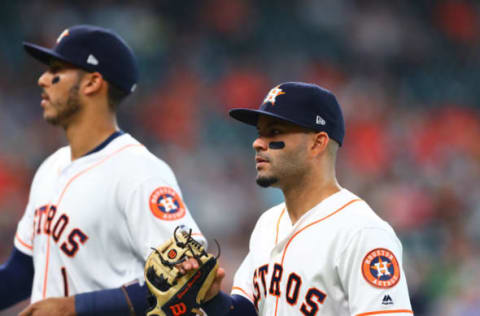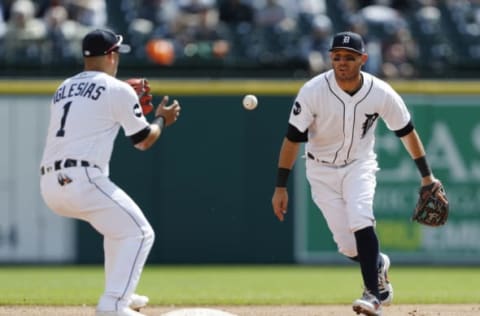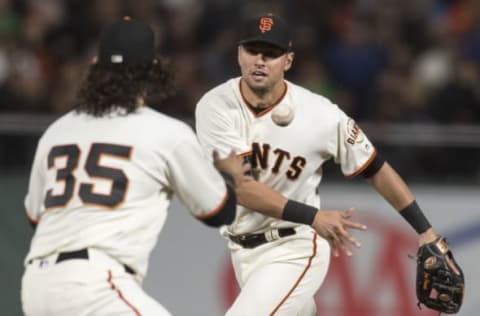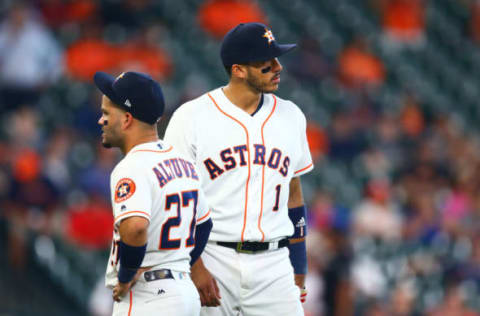MLB: Best Double Play Combos in Baseball


A MLB team’s shortstop and second base duo has the potential make or break their defense and their lineup. Let’s take a look at the best double play combos in the business.
When I talk about the best double play combo in the business, what do you look at? Defense, offense, or a mix of the two? On Friday, Fangraphs took a poll of the best double play combos in baseball. While I won’t be using their same methodology, they did collect a few stats that will be helpful for this piece. To be fair, they were only looking at shortstop/second base combos that have been together for at least 200 games since 2015. In contrast, I will weigh last year more than the seasons preceding it.
So if we’re being literal, the best duo at turning double plays is either in Detroit or Baltimore. Of course, that’s not even looking at all defensive metrics. If we’re looking at just range, the Indians and Giants are far superior to the rest. In terms of overall defense, the Giants and Indians also rank first and second in the league since 2015, respectively.
More from Call to the Pen
- Philadelphia Phillies, ready for a stretch run, bomb St. Louis Cardinals
- Philadelphia Phillies: The 4 players on the franchise’s Mount Rushmore
- Boston Red Sox fans should be upset over Mookie Betts’ comment
- Analyzing the Boston Red Sox trade for Dave Henderson and Spike Owen
- 2023 MLB postseason likely to have a strange look without Yankees, Red Sox, Cardinals
That’s just in terms of on-paper defense, and according to just one article by Fangraphs. Of course, I’m here to do more than that. I’m here to discuss offense, and defense, and hopefully find a way to combine the two. Wins Above Replacement won’t necessarily make my decisions for me, but realistically it’s the perfect statistic to gauge this kind of thing.
Due to a few untimely injuries, there are some notable double play combos that will not make this list. Specifically, the Mariners, Dodgers, and Rockies are all missing big name infielders that would change the landscape of this ranking system. Other top performers such as the Diamondbacks just haven’t had enough success to prove they can last. For the Red Sox, it’s an issue of defensive capability.
Honorable Mentions: Cano/Segura (Seattle), Forsythe/Seager (Los Angeles), LeMahieu/Story (Rockies), Pedroia/Bogaerts (Boston), Drury/Owings (Arizona)

2B Ian Kinsler & SS Jose Iglesias, Detroit Tigers
If this was based strictly on defense, the Tigers would have one of the top-2 double play combos in the game. For years, Kinsler has been a slugger at second base and a more than solid defender. Iglesias is much more well-known for his glove, but has had a decent bat as well. At the moment, Kinsler is hitting .248, while Iglesias is at .200. Since 2014, Kinsler has averaged over 5 fWAR per year thanks to his steady glove work and offensive skills. Iglesias has always been the light-hitting type, but hasn’t gotten into rhythm yet. If not for their defensive prowess, the Tigers’ tandem up the middle would not have made this list.
That’s the thing, though. Kinsler and Iglesias aren’t just a couple of solid defenders up the middle: they’re truly excellent. Last year alone, they combined for a whopping 7.9 fWAR. Their most memorable play was likely this one from back in 2015.
Sure, that was a few years ago. So what can you do for me now?
As it turns out, their defensive cohesion and skill might actually outweigh their offensive shortcomings.
Sliding plays? Check. Throws across the body? Check. Quick Hands? Check. Legitimate range? No doubt. Despite their negative production in the batter’s box this year, the Kinsler/Iglesias duo is still one of the top double play combos in baseball. Kinsler will likely rebound from a slow start at the plate, and Iglesias probably won’t be hovering around the Mendoza line forever. While the biggest names in Detroit are undoubtedly Cabrera and Verlander, the contributions of Ian Kinsler and Jose Iglesias should not be overlooked.

2B Joe Panik & SS Brandon Crawford, San Francisco Giants
Much like the Tigers’ duo, the defensive greatness of Brandon Crawford and Joe Panik cannot be ignored. Crawford is more well-known for his glove than Panik, but both are excellent defenders. If I were basing this ranking just on defensive ability, this combo would be ranked in first place. Panik made an early impression in the majors after saving a run in Game 7 of the 2014 World Series, and hasn’t looked back since.
Crawford, on the other hand, is famous for his cannon of an arm:
It took Crawford a few years to get things going, but he’s averaged a 110 wRC+ in the past two seasons. Crawford blasted 21 homers back in 2015, and hit a career high .275 last year. Panik is more of a spray/contact hitter, but he’s done his job well. In parts of three seasons, Panik has a career .277 batting average with 7.9 fWAR. He’s primarily hit at the top of the lineup, which is perfect for a guy like Panik. Since coming into the league, his 10.1 K/9% is the 6th lowest in baseball. He’s been an ideal No. 2 hitter in the lineup for the Giants, and holds down the keystone position like a pro.
Last year, Panik and Crawford combined for 7.9 fWAR. It’s hard not to put this group higher up on the list, but they just haven’t done enough offensively to be considered the best all-around double play combo. Defense counts for a lot, but it’s not everything.

2B Jose Altuve & SS Carlos Correa, Houston Astros
Of all the double play combos on this list, the duo of Carlos Correa and Jose Altuve is by far the most intimidating. Last year, these two combined for 44 home runs, 192 RBI and 43 stolen bases. Their defense does not hold a torch to the previous mentions in this piece, but their offensive output is just too impressive to brush aside. Let’s be real here: it’s no coincidence that the Astros have been a playoff caliber team since Carlos Correa has come into the league. Last year alone, Altuve and Correa combined for an 11.6 fWAR.
Altuve came into the league as a light-hitting speed demon back in 2011. Since then, he’s evolved into a slugger and a batting champion. He’s never been a premier defender, but the benefits far outweigh the drawbacks. After all, Jose Altuve is the kind of player that can do this all in one game:
In Correa, you just have your typical 6-4 power-hitting shortstop. You may ask yourself, “what is a typical 6-4 shortstop?” The answer is
Jr. and
. Correa, Ripken Jr. and Seager are the only shortstops in MLB history to measure in at 6-4. They’ve all got another thing in common, too: power. Lots of it. Correa is big, and he’s athletic. In less than two full season’s worth of games, Correa has 48 home runs and 9.8 fWAR to his name. He makes the plays, and he crushes the ball. What more could you ask for in a shortstop? If you don’t believe me, just watch.
This duo is young, fun to watch, and dangerous to face.

2B Jason Kipnis & SS Francisco Lindor, Cleveland Indians
With all due respect to the other players named thus far, you could pair Francisco Lindor with a bag of pine tar and the Indians would still have the number one double play combo. Quite frankly, Lindor has just been that good. Since coming into the league in 2015, Lindor has been worth 12.5 fWAR. He’s a switch hitter, he’s got some pop, he can run, and his glove is golden. As good as Correa has been, Lindor has been worth nearly 3 wins more than him in just an additional seven games played. In 2016 alone, Lindor batted .301 with 15 bombs, 99 runs scored, and a 112 wRC+. He already has nine home runs under his belt in 2017, including this colossal shot:
Lindor is the true core piece of the Indians team, and he’s made even better by Jason Kipnis. Kipnis, now 30, has established himself as a quality second baseman with the glove, and is a power threat at the plate. Though he’s has some trouble staying healthy, Kipnis has been very productive when on the field. Over the past two seasons he’s averaged 4.9 fWAR, which is 3rd behind just Altuve and Kinsler. Last season, Kipnis put it all together and hit .275 with 23 home runs.
Between Kipnis and Lindor, the Indians hgot 11.1 fWAR out of their middle infielders in 2016. The Astros duo edges them out by half a win, but that’s why WAR isn’t the end-all answer to everything. What the Tribe’s double play combo has that the Astros doesn’t is a balanced skill set. Kipnis and Lindor are both great hitters, but they’re just as good, if not better, defensively.
Next: Yankees Retire Jeter's No. 2
If you just go off of the numbers, it’s a pretty close debate. However the eye test makes it pretty clear that Lindor and Kipnis are a superior double play duo than any other tandem in the league at this time.